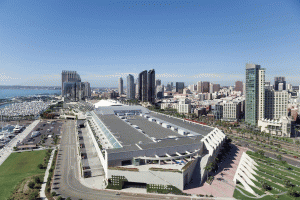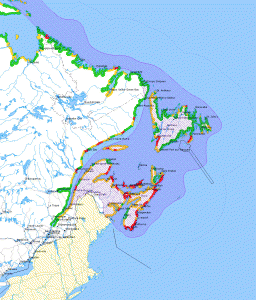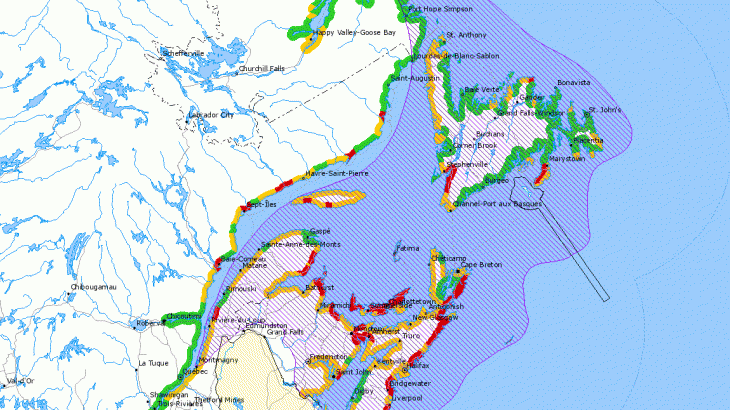Sarah Boon and Sri Ray-Chauduri, Environment & Earth Science co-editors
At almost 240,000 km, Canada has the longest coastline in the world. Over seven million Canadians live in coastal regions along the Pacific, Arctic, and Atlantic Oceans, many of whom are likely paying close attention to recent news about both historic and future global sea levels.
In examining historic sea levels, a study published in Nature Climate Change found that current rates of sea level rise are the highest of the past 28 centuries. The results prompted the researchers to state that, “the stable climate in which human civilization has flourished for thousands of years, with a largely predictable ocean permitting the growth of great coastal cities, is coming to an end.”
Delving more deeply into what we might see in the future, a study published in Nature used a newly validated ice sheet and climate dynamics model to show that Antarctic melt could contribute significantly to sea level rise under a high greenhouse gas emission scenario. By the end of this century, ice melt from Antarctica plus the other ice sheets could potentially increase global average sea level by 1.5 to 2 metres.
Grasping the significance of a 1 to 2 metre increase in sea level is about more than watching stunning footage of ice shelves calving into the ocean. The damage and cost to coastal areas and habitats from increased coastal flooding affects the everyday lives of regular people. Elizabeth Kolbert describes the scene in Miami, where “water gushed down the road and into an underground garage…In front of a four-story apartment building, which was surrounded by a groomed lawn…water seemed to be bubbling out of the turf. [In a] neighborhood of multimillion-dollar homes…water was creeping under the security gates and up the driveways. Porsches and Mercedeses sat flooded up to their chassis.”
It’s clear that sea level rise is affecting more than just low-lying islands in far off corners of the world like the Maldives, or some futuristic Manhattan at the end of the century. It’s happening now, and it has implications for Canadian communities.

Click for visualization of sea level rise in San Diego (Images by Nickolay Lamm, used with permission).
On Canada’s Pacific coast, sea level rise is partially offset by the fact that the land is still rising in response to the removal of ice after the last glaciation (isostatic rebound); however, sea level is still expected to rise 1 metre by 2100. A study quantifying the cost of flooding in over 100 coastal cities worldwide listed Vancouver among the 15 most vulnerable ports. Using previous (conservative) sea level rise estimates, the study predicted average global annual losses of over $60 billion USD by 2050.
In the Arctic, communities on the Tuktoyaktuk Peninsula are being hit with a triple whammy of reduced sea ice (which often protects shorelines from storm activity), increased storm activity (due to more open water), and thawing permafrost. They’ve already had to abandon an elementary school, houses, and other buildings. The added problem of sea level rise puts Arctic coastal communities at an even greater risk of losing vital infrastructure, and their coastal land base.
Atlantic Canada, unlike the West Coast, is experiencing isostatic submergence following the last glaciation, which means that some areas are declining in elevation. This – along with a stronger storm surge due to a warming ocean – increases the risks from sea level rise. Recent studies show that Prince Edward Island (PEI) and Nova Scotia are particularly vulnerable; the latter is expecting 0.7–1.4 m of sea level rise over the next century. After showing the public a visualization of PEI sea level rise, one researcher said, “I had grown men crying as they watched their investments being swamped by water.”

Coastal sensitivity to sea level rise on the Atlantic coast. The shaded area is undergoing submergence, and the colored areas show low (green) to high (red) sensitivity to sea level rise (Map from Shaw et al. 1998. Sensitivity of the Coasts of Canada to Sea-level Rise. Geological Survey of Canada Bulletin 505.).
So what can we do about it?
It may not be a good idea to follow Florida’s lead, where researcher Nicole Hernandez Hammer says, “the infrastructure we have is built for a world that doesn’t exist anymore.” Despite ongoing ‘nuisance flooding’ and dire predictions of sea level rise, Miami continues to approve major housing developments in high risk areas, and is only just beginning to develop plans to deal with increasing sea level.
Rather than merely engineering short-term solutions in response to issues caused by sea level rise, a more proactive approach seeks to combine engineering with more natural defences, and develop a regulatory framework that supports evidence-based decision-making about coastal development.
In The Netherlands, for example, a network of dikes and water barriers has kept a country with more than half of its landmass at or below sea level dry for more than 1,000 years. Recently, the Dutch have begun to work with nature to help manage the problem of sea level rise. They’re building hybrid dikes, which use vegetation such as willow forests to dissipate the effect of wave action before it reaches the dike infrastructure. They’re also placing massive sand deposits along the coast, allowing the ocean to rework these sediments into coast-protecting beaches downstream.
Other examples of working with nature to manage sea level rise include South Cape May Meadows, New Jersey, where a linked freshwater wetland and beach ecosystem was restored to effectively protect local communities from coastal flooding. In Louisiana, the Nature Conservancy has been working with several groups to restore oyster reefs, which protect the coastline from storm surges and sea level rise.
In situations where restored wetlands or hybrid dikes are not effective adaptation strategies, examples such as Germany’s HafenCity (south of the main Hamburg dike) become relevant. This city is flood-proofing itself by elevating buildings on “plinths” (mounds of compacted fill) that are 8 to 9 metres above sea level. The first floors of these buildings are being targeted for non-residential use, and will use flood-proof doors to help minimize potential flood losses from sea level rise.
Here in Canada, our existing decision making framework for addressing coastal hazards due to sea level rise does include accommodation, or “working with nature” as described above. It also includes armour and/or protect, where you build up coastal defences against flooding; retreat, in which you move existing development out of zones at high risk of sea level rise; and avoid, in which you plan future developments outside of areas considered to be at high risk of coastal flooding (e.g., “no-build” areas).
The use of any or all of these approaches requires adaptation tools. Vancouver, for example, has included coastal flood risk assessment in its climate change adaptation strategy. Provincially, the BC government has also developed a number of initiatives to both visualize and manage coastal sea level rise. BC’s adaptation tools include planning tools such as coastal hazard mapping; regulatory tools such as building design regulations; land use tools such as establishing land trusts; structural tools such as the construction of dikes and seawalls; and non-structural tools such as wetlands and beach nourishment – the same “work with nature” approach outlined above.
Effective coastal management ultimately requires a combination of these approaches, plus a commitment to stay up-to-date on both the latest science on sea level rise and the current condition of coastal areas.
So if you’re not quite sure how to grasp the latest science on sea level rise, think instead about the potential local costs of flooding from rising sea levels. These impacts drive our current decision-making, and will affect our ability to effectively adapt to future conditions.
For more images of coastal flooding in major cities worldwide due to sea level rise, see this series by Climate Central.





2 thoughts on “Working with sea level rise, not against it”
Comments are closed.